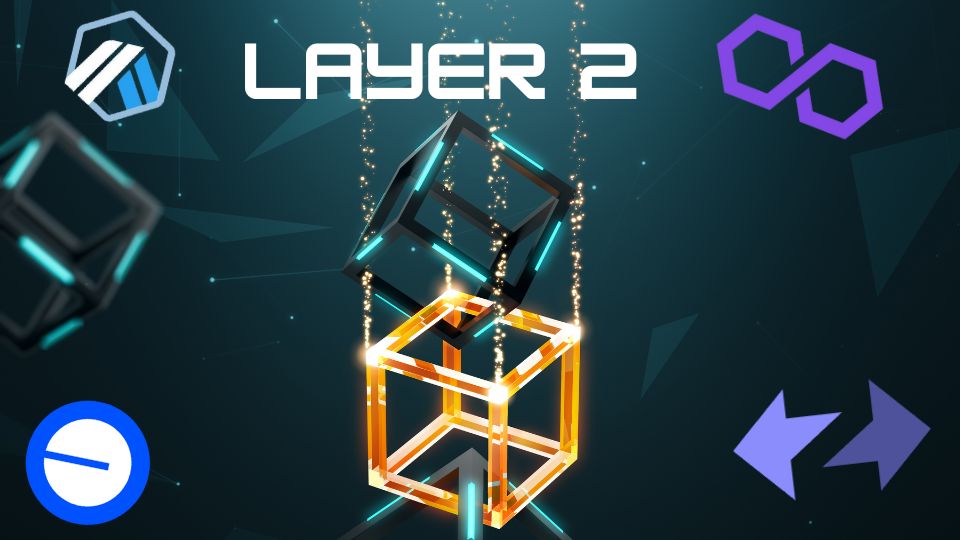The blockchain layered ecosystem was developed to help solve numerous scalability, efficiency, and cost challenges. Layer 1 and Layer 2 networks are specific keys to this evolution. These layers serve different functions but ultimately work together to enhance blockchain performance.
What Are Layer 1 and Layer 2 Networks?
Layer 1 networks, also known as base-layer blockchains or L1, are the foundational protocols that form the underlying infrastructure of a blockchain. They are responsible for handling consensus mechanisms, security, and governance of the entire blockchain. These networks serve as the bedrock upon which decentralized applications (dApps) are built. Prominent Layer 1 networks include Bitcoin, Ethereum, and Solana.
“Mainnet” is the live, fully functional blockchain network where real transactions occur, and decentralized applications run on Layer 1 blockchains. It’s the production version, unlike “testnets”, which are used for testing.
Layer 2 networks, on the other hand, are built on top of Layer 1 networks to improve scalability and performance. They are often referred to as “off-chain” solutions or L2s because they process transactions outside the main Layer 1 blockchain.
After processing, all of these L2 transactions are later settled on the base layer. The main idea behind Layer 2 networks is to relieve the pressure from Layer 1 networks by handling a large volume of transactions more efficiently.
What’s the Big Deal About Blockchain Layer 2s?
The future of Ethereum scaling lies in rollups (layer 2 solutions) and eventually, Ethereum 2.0. But the next stage of Ethereum’s growth will see multiple layer 2 networks interacting seamlessly with the base layer to handle millions of transactions per second, without compromising decentralization or security.
Layer 2 networks were born out of necessity. The earliest blockchains, like Bitcoin and Ethereum, were designed with decentralization and security in mind. However, they soon encountered scalability issues as more users and applications started relying on them.
For example, Bitcoin’s proof-of-work consensus mechanism is known for its robustness, but it is also slow and resource-intensive. It can only handle about 7 transactions per second (TPS). This leads to high fees and longer confirmation times during periods of heavy network traffic.
Ethereum, which is widely used for decentralized applications and smart contracts, initially faced similar bottlenecks. Although its TPS is higher at 15 transactions per second, it still suffers from essentially the same issues as Bitcoin.
To combat these scalability issues, developers started building Layer 2 solutions. These second layers could handle a significant portion of the transaction load without compromising the security and decentralization of the base layer.
The ultimate goal was to increase transaction throughput while reducing costs, making blockchain more accessible to a broader range of applications.
Prominent Blockchain Layer 1 Networks by Market Capitalization

Market capitalization is an important metric for Layer 1 networks because it reflects the total value of the network’s native cryptocurrency and signifies the network’s overall influence, security, and adoption.
Larger market capitalizations generally indicate more established networks with broader adoption and higher security, which are critical for foundational blockchains. Bitcoin leads the pack in this regard.
Here are some of the top Layer 1 networks, ranked by market capitalization as of August 2024:
- Bitcoin (BTC)
- Market Cap: $1.18 trillion
- Overview: Bitcoin is the first and most prominent cryptocurrency, recognized for its security and decentralization. It primarily serves as a store of value and a medium of exchange.
- Details: Bitcoin’s proof-of-work consensus mechanism ensures network security but limits its transaction throughput, leading to higher fees during periods of congestion.
- Use Cases: Store of value, peer-to-peer payments.
- Ethereum (ETH)
- Market Cap: $303.43 billion
- Overview: Ethereum is the leading platform for decentralized applications (dApps) and smart contracts. It has become the foundation for most DeFi projects and NFTs.
- Details: Ethereum’s smart contract functionality enables a vast ecosystem of decentralized finance (DeFi), non-fungible tokens (NFTs), and decentralized autonomous organizations (DAOs). However, high gas fees and network congestion are ongoing challenges.
- Use Cases: DeFi, NFTs, dApps, smart contracts.
- BNB Chain (BNB)
- Market Cap: $80.22 billion
- Overview: BNB Chain (formerly Binance Smart Chain) is known for fast and low-cost transactions, making it a popular choice for DeFi applications and decentralized exchanges.
- Details: BNB Chain’s compatibility with Ethereum’s virtual machine (EVM) allows developers to easily port their applications from Ethereum, contributing to its rapid adoption.
- Use Cases: DeFi, dApps, payments.
- Solana (SOL)
- Market Cap: $66.22 billion
- Overview: Solana is a high-performance blockchain known for its ability to process up to 65,000 transactions per second (TPS) with extremely low fees, making it highly scalable.
- Details: Solana’s Proof of History (PoH) mechanism enables high throughput and low latency, making it ideal for high-frequency applications like trading and gaming.
- Use Cases: DeFi, NFTs, gaming.
- Toncoin (TON)
- Market Cap: $18.85 billion
- Overview: Developed by the team behind Telegram, Toncoin is designed for high scalability and security, enabling fast transactions and microtransactions.
- Details: Toncoin supports secure messaging, decentralized finance (DeFi) applications, and smart contracts, positioning it as a versatile platform for a variety of use cases.
- Use Cases: Secure messaging, DeFi, microtransactions.
- Tron (TRX)
- Market Cap: $14.76 billion
- Overview: Tron is designed to create a decentralized internet, focusing on high throughput and low transaction fees, particularly for content sharing and entertainment.
- Details: Tron’s consensus mechanism allows it to process transactions quickly, making it a popular choice for decentralized applications (dApps) and content platforms.
- Use Cases: Content sharing, decentralized applications, DeFi.
- Cardano (ADA)
- Market Cap: $12.77 billion
- Overview: Cardano is a proof-of-stake blockchain that prioritizes sustainability and scalability through a rigorous, research-driven approach.
- Details: Cardano’s unique layered architecture separates the settlement and computation layers, enhancing flexibility and security. Its Ouroboros consensus mechanism is designed for energy efficiency.
- Use Cases: Smart contracts, DeFi, identity management.
- Avalanche (AVAX)
- Market Cap: $9.70 billion
- Overview: Avalanche is a high-speed blockchain platform that supports customizable subnets, allowing for scalable decentralized applications and enterprise use cases.
- Details: Avalanche’s Avalanche consensus protocol is known for its low-latency finality, which makes it a strong contender for applications requiring fast and secure transactions.
- Use Cases: DeFi, NFTs, custom blockchains.
- Polkadot (DOT)
- Market Cap: $4.33 billion
- Overview: Polkadot is designed for interoperability between different blockchains, enabling them to communicate and share security through a unique architecture of parachains.
- Details: Polkadot’s relay chain coordinates the network’s consensus and interoperability, while parachains are custom blockchains optimized for specific use cases.
- Use Cases: Interoperability, DeFi, cross-chain communication.
- NEAR Protocol (NEAR)
- Market Cap: $4.90 billion
- Overview: NEAR Protocol is a sharded blockchain that focuses on high throughput and developer usability, offering a user-friendly platform for building decentralized applications.
- Details: NEAR’s sharding approach allows the network to scale efficiently, distributing the load across multiple parallel chains while maintaining security and decentralization.
- Use Cases: dApps, gaming, DeFi.
- Internet Computer (ICP)
- Market Cap: $3.65 billion
- Overview: Internet Computer is a decentralized cloud computing platform that enables applications to run directly on the blockchain, offering an alternative to traditional cloud services.
- Details: Internet Computer’s architecture is designed to scale horizontally, providing the infrastructure needed to support a vast range of decentralized applications and services.
- Use Cases: Cloud computing, DeFi, dApps.
- Cosmos (ATOM)
- Market Cap: $2.47 billion
- Overview: Cosmos aims to create an “Internet of Blockchains,” facilitating interoperability between independent blockchains through the Inter-Blockchain Communication (IBC) protocol.
- Details: Cosmos is built on the Tendermint consensus engine, which offers fast finality and robust security. It enables cross-chain transactions and communication, fostering a highly interconnected blockchain ecosystem.
- Use Cases: Interoperability, DeFi, cross-chain communication.
- Hedera Hashgraph (HBAR)
- Market Cap: $2.51 billion
- Overview: Hedera Hashgraph uses a novel consensus algorithm called Hashgraph, providing fast, secure transactions with low fees and high throughput.
- Details: Hedera’s governance model includes a council of global enterprises that oversee the network, ensuring stability and decentralization. The Hashgraph consensus algorithm offers a high level of efficiency and security.
- Use Cases: Micropayments, DeFi, tokenization.
- Fantom (FTM)
- Market Cap: $1.29 billion
- Overview: Fantom is a highly scalable blockchain platform that uses a unique consensus algorithm called Lachesis to deliver fast and low-cost transactions.
- Details: Fantom’s Lachesis consensus is an Asynchronous Byzantine Fault Tolerant (aBFT) protocol, which provides fast confirmation times and high throughput, making it ideal for DeFi applications.
- Use Cases: DeFi, smart contracts, dApps.
- Algorand (ALGO)
- Market Cap: $1.03 billion
- Overview: Algorand employs a Pure Proof of Stake (PPoS) consensus mechanism, providing fast and low-cost transactions with a focus on security and decentralization.
- Details: Algorand is designed to handle a large number of transactions with immediate finality, making it well-suited for applications requiring high speed and low latency.
- Use Cases: Payments, DeFi, dApps.
- Tezos (XTZ)
- Market Cap: $651 million
- Overview: Tezos is a self-amending blockchain that supports on-chain governance, enabling continuous evolution and upgrades without needing hard forks.
- Details: Tezos’ liquid proof-of-stake consensus allows stakeholders to participate in governance decisions, making the blockchain adaptable to future developments.
- Use Cases: Smart contracts, DeFi, NFTs.
Prominent Blockchain Layer 2 Networks by Total Value Locked

For Blockchain Layer 2 networks, Total Value Locked (TVL) is a crucial metric. It measures the total amount of assets secured in a network’s smart contracts, indicating how much trust and adoption the Layer 2 solution has gained within the ecosystem. High TVL signifies that more users and developers are actively using the network to deploy assets and applications, making it a strong indicator of network success.
Here are the top Layer 2 networks, ranked by TVL as of August 2024:
1. Arbitrum One
- TVL: $2.67 billion
- Overview: Arbitrum One is the leading Layer 2 solution for Ethereum, known for its use of optimistic rollups to enhance scalability.
- Details: Arbitrum was developed by Offchain Labs and launched in 2021. It quickly gained traction due to its ability to reduce gas fees while maintaining Ethereum’s security. Arbitrum is particularly distinguished by its early and widespread adoption in the DeFi space, where it has become a cornerstone for many of the most popular decentralized applications.
- Base Layer: Ethereum
2. Base
- TVL: $1.50 billion
- Overview: Base is a Layer 2 network developed by Coinbase, aimed at providing a secure and low-cost environment for decentralized applications.
- Details: Launched in 2023, Base stands out due to its deep integration with Coinbase’s ecosystem, offering a seamless user experience from exchange to Layer 2. This has made Base highly accessible to a broad range of users and developers, rapidly increasing its adoption and TVL.
- Base Layer: Ethereum
3. Polygon PoS
- TVL: $884 million
- Overview: Polygon PoS is a popular Layer 2 solution that uses a proof-of-stake sidechain to scale Ethereum, providing low-cost transactions and high throughput.
- Details: Polygon, originally known as Matic Network, was one of the first projects to offer a scalable Layer 2 solution for Ethereum. What sets Polygon apart is its broad ecosystem and support for various scaling techniques, including sidechains and zk-rollups, making it a versatile platform for a wide array of applications.
- Base Layer: Ethereum
4. Blast
- TVL: $818 million
- Overview: Blast is an emerging Layer 2 solution focused on providing high-speed transactions and scalability for decentralized applications.
- Details: Blast has distinguished itself by catering specifically to high-frequency trading and gaming applications, where ultra-low latency and fast transaction times are critical. Its emphasis on these sectors has attracted a niche but rapidly growing user base.
- Base Layer: Ethereum
5. Scroll
- TVL: $693 million
- Overview: Scroll is a Layer 2 solution designed to bring scalability and security to Ethereum using zk-rollups.
- Details: Scroll is unique for its focus on zero-knowledge proofs (zk-rollups), which provide both scalability and enhanced privacy. Unlike many other Layer 2 solutions, Scroll has a strong emphasis on privacy, making it particularly attractive for developers looking to build secure and confidential dApps.
- Base Layer: Ethereum
6. Optimism
- TVL: $598 million
- Overview: Optimism is a prominent Layer 2 scaling solution for Ethereum, using optimistic rollups to increase transaction speed and lower costs.
- Details: Optimism is notable for its commitment to public goods funding and its close collaboration with the Ethereum community. The network has implemented retroactive public goods funding, where a portion of transaction fees is allocated to support open-source development, setting it apart from other Layer 2s.
- Base Layer: Ethereum
7. Linea
- TVL: $525 million
- Overview: Linea is a Layer 2 solution focused on providing high throughput and low-latency transactions for decentralized applications.
- Details: Linea stands out due to its specialized architecture designed for low-latency applications. This focus has made Linea particularly popular in the gaming and real-time data processing sectors, where speed is of the essence.
- Base Layer: Ethereum
8. Mantle
- TVL: $473 million
- Overview: Mantle is a Layer 2 scaling solution that focuses on providing a secure and scalable environment for decentralized applications on Ethereum.
- Details: Mantle differentiates itself with a strong focus on enterprise adoption. The network has been optimized to meet the needs of large-scale organizations, providing the scalability and security required for enterprise-grade applications. This focus has attracted significant interest from businesses looking to leverage blockchain technology.
- Base Layer: Ethereum
9. Gnosis Chain
- TVL: $246 million
- Overview: Gnosis Chain is a Layer 2 solution focused on decentralized finance, providing scalable infrastructure for DeFi applications.
- Details: Gnosis Chain is unique in its origins, having evolved from a prediction market platform into a full-fledged Layer 2 solution with a strong emphasis on governance and decentralized finance. It has a dedicated community and governance structure that supports experimentation and innovation in DeFi.
- Base Layer: Ethereum
10. Stacks
- TVL: $91 million
- Overview: Stacks is a unique Layer 2 solution for Bitcoin, enabling smart contracts and decentralized applications on the Bitcoin network.
- Details: Stacks is distinct in that it brings smart contract functionality to Bitcoin, which traditionally lacks this capability. By leveraging the security of the Bitcoin network while enabling new use cases like DeFi and NFTs, Stacks has carved out a niche as the go-to Layer 2 solution for developers wanting to build on Bitcoin.
- Base Layer: Bitcoin
Why Do Ethereum Layer 2s Significantly Outnumber Those on Other Blockchains?
While Blockchain Layer 2 solutions are being developed for other Layer 1 blockchains, they are less prominent than Ethereum-based Layer 2s due to several key factors:
1. Ethereum’s Dominance in dApps and DeFi
- Large Developer Ecosystem: Ethereum hosts the largest and most active developer community in the blockchain space, particularly for decentralized finance (DeFi) and decentralized applications (dApps). This creates a massive demand for Layer 2 solutions to scale Ethereum.
- DeFi and Other Growing Applications: Ethereum remains the hub for DeFi, gaming, DAOs, supply chain management, tokenization of assets, identity solutions, and payments, all of which require frequent transactions that benefit from the scalability and cost reductions provided by Layer 2 solutions. While the NFT boom has waned, these diverse applications continue to drive demand for scalable infrastructure.
2. Focus of Other Blockchain Layer 1s on Scalability
- Inherent Scalability: Many alternative Layer 1 blockchains, such as Solana, Avalanche, and Binance Smart Chain, were designed with scalability in mind. These blockchains use innovative consensus mechanisms like Proof of History (Solana) or subnets (Avalanche) to achieve higher throughput and lower costs at the base layer. As a result, they don’t yet have as strong a need for Layer 2 solutions as Ethereum does. For example, Solana averages 400 user-generated TPS, but can increase to over 2,000 TPS during peak demand periods.
- Different Architectures: Some Blockchain Layer 1s, such as Polkadot and Cosmos, focus on interoperability and parallel processing through parachains and hubs, which serve similar purposes to Layer 2s. In these ecosystems, the scaling solutions are integrated into the Layer 1 design, reducing the need for separate Layer 2 projects.
3. Early Stage of Development for Non-Ethereum Layer 2s
- Still Emerging: Layer 2 solutions for other Layer 1 blockchains are still in their early stages of development and have not yet gained the same level of adoption as Ethereum’s Layer 2s. However, projects are emerging that aim to bring Layer 2 solutions to blockchains like Solana and Binance Smart Chain, but these have not yet reached the same level of prominence.
- Smaller Ecosystems: Other Layer 1 blockchains have smaller ecosystems in terms of both user base and developer activity compared to Ethereum. As a result, the demand for Layer 2 scaling solutions is lower, leading to fewer projects and less innovation in this area.
4. Ethereum’s Layer 2 Innovation Leadership
- zk-Rollups and Optimistic Rollups: Ethereum has been a leader in advancing Blockchain Layer 2 technologies, particularly zk-rollups and optimistic rollups. These innovations have attracted significant investment and developer interest, solidifying Ethereum’s position as the primary hub for Layer 2 solutions.
- Related: Scaling Solutions for Web3 Games: Overcoming Blockchain’s Limitations
- Related: Bitcoin Mining Today: Key Players, Challenges, and Future Trends
What are zk-Rollups and how do They Work?
- Off-Chain Transaction Processing: zk-rollups bundle hundreds or thousands of transactions off-chain. Instead of each individual transaction being processed and verified on the Layer 1 blockchain, they are processed off-chain.
- Zero-Knowledge Proofs: For each batch of off-chain transactions, the zk-rollup generates a cryptographic proof known as a zero-knowledge proof (often specifically a zk-SNARK or zk-STARK). This proof demonstrates that the batch of transactions was processed correctly according to the rules of the blockchain.
- On-Chain Verification: The zk-rollup smart contract on the Layer 1 blockchain (e.g., Ethereum) only needs to verify the zero-knowledge proof, not each individual transaction in the rollup. This significantly reduces the amount of data and computation required on Blockchain Layer 1s.
- Security: Since the zero-knowledge proof ensures that all transactions in the rollup batch are valid, zk-rollups maintain the same level of security as the underlying Layer 1 blockchain.
Key Benefits of zk-Rollups
- Scalability: By processing multiple transactions off-chain and only submitting a succinct proof to the Layer 1 blockchain, zk-rollups drastically reduce the computational load and increase throughput.
- Lower Costs: Because fewer transactions are directly processed on the Layer 1 blockchain, gas fees are reduced for users. This makes zk-rollups ideal for scaling Ethereum, where gas fees can become expensive during periods of congestion.
- Security: zk-rollups inherit the security of the Layer 1 blockchain since the zero-knowledge proof ensures the correctness of off-chain transactions.
Use Cases of zk-Rollups
zk-rollups are particularly useful for:
- Decentralized finance (DeFi): zk-rollups can process large volumes of transactions for decentralized exchanges (DEXs) and other DeFi platforms, reducing fees and increasing speed.
- Payments: zk-rollups can batch and validate many small payments at once, making microtransactions and remittances more efficient.
- NFTs and Gaming: zk-rollups can help reduce costs associated with minting and transferring NFTs or performing in-game transactions on the blockchain.
Blockchain Layers are Critical
Blockchain Layer 1 and Layer 2 networks serve complementary roles. While Blockchain Layer 1s provide the foundational security and decentralization, Blockchain Layer 2s offer a way to scale and make the entire chains more efficient for a wider range of applications.
Layer 2 solutions are the gateway to bringing the next billion users to Web3. They offer the scalability and low fees that are necessary for DeFi to truly achieve mass adoption.”
The combination of both is helping the blockchain ecosystem move toward mass adoption by solving the scalability trilemma without compromising on security or decentralization. Whether it’s enabling faster and cheaper transactions through Blockchain Layer 2 networks or improving the foundational aspects of Blockchain Layer 1 networks, this layered approach is critical to ensuring the long-term viability and scalability of decentralized systems.





